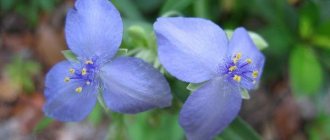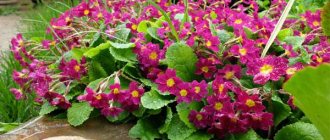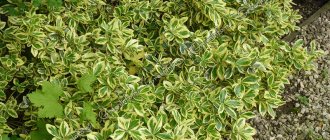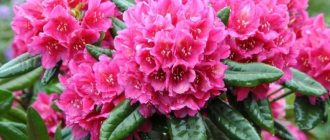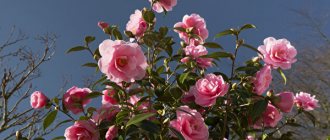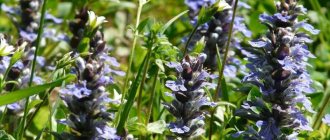Do you want your garden to turn into a celebration of color from spring to summer? So, look at the bright and unforgettable representative of the heathers - the azalea. The popularity of garden azaleas is growing every year, and frost-resistant plant varieties can withstand temperatures down to -30 °C and winter quietly in open ground. All you need to do is position the plant correctly and create favorable conditions for it.
Briefly about care
| Type of agricultural operation for caring for garden azaleas | Description of conditions and actions |
| Watering and air humidity | After the soil surface has dried, water with settled water at a distance of 20 cm from the center of the bush (acidify the water with citric acid once a month). In extreme heat, the bush is sprayed |
| Location organization | A flat area with partial shade, sheltered from drafts and flooding by spring waters, good if there is a garden or park pond nearby |
| Favorable neighborhood | Spruce (tap root), linden with small leaves, oak |
| Optimal temperature conditions | In summer +20 °C +25 °C, in winter it can withstand up to -27 °C -32 °C |
| Planting and transplanting | Beginning of March or September |
| Soil requirements | Garden soil is mixed with sand, turf, a sufficient layer of drainage (crushed red brick, crushed stone) is placed at the bottom of the hole, and pine needles, sawdust or shavings, and mown grass are used as mulch. |
| Fertilizer application | During the budding-flowering period, the plant requires potassium and phosphorus, and after flowering, the azalea is watered with a solution of phosphorus-potassium fertilizers (1:2) |
| First flowers | 3-4 years after planting in April-May |
| Trimming | Sanitary pruning is done in early spring, and formative pruning is carried out after the flowers have withered. |
Kinds
Inhabiting the mountainous areas of the Himalayas, the Caucasus, Europe and America, the heather family has given us about 800 species of rhododendron. And only a small part of them are able to develop successfully in our temperate but cold latitudes. Among them are the deciduous rhododendron Molle, the evergreen Fortune, and the evergreen but blushing Russatum, which adorns the alpine hills of our gardens . In the vast expanses of Siberia, Daurian rhododendron grows under natural conditions, which is often confused with wild rosemary.
Rhododendron "Molle"
Rhododendron "Fortune"
Advice! Since the characteristics of the genus include the distribution of plants into evergreen and deciduous trees, bushes and subshrubs, you have to base your choice on these indicators.
Beautiful rhododendron "Daursky"
Soft purple “Russatum Gletschernacht”
Japanese rhododendron, which is a very branched deciduous shrub, is taking root well here. The evergreen rhododendron is also suitable for our gardens. It is dense, tolerates frost well, but grows very slowly.
Rhododendron "Japanese"
In many European catalogs, rhododendron is called azalea. Therefore, flower growers agreed that the azalea flower is a species of rhododendron growing indoors. They are used in home floriculture, decorating window sills, winter gardens and greenhouses. The exception is the garden azalea, but in order for it to take root in the open air, a lot of effort must be made.
Azalea will serve as a wonderful decoration for your home
Those who are interested in the beneficial properties of the plant should take a closer look at Adams rhododendron, which has a tonic effect.
Rhododendron "Adams" has a tonic effect
We advise lovers of lush flowering shrubs to plant Katevbinsky rhododendron in the garden. The shrub, 2 to 4 meters high, during the flowering period turns into a huge ball of brightly colored inflorescence petals, completely covering the green leaf of the rhododendron.
Lush blooming rhododendron shrub "Katevbinsky"
Deciduous varieties of rhododendron differ in their winter hardiness. These are Limon Lights and Mandarin Lights, with a rare lemon- yellow color and delicate aroma. Among the evergreen rhododendrons, it is worth noting such varieties as Haaga, Mauritz and Peter Tigerstedt.
Rhododendron "Limon Lights"
Rhododendron "Peter Tigerstedt" with its snow-white flowers
Today, when the army of hybrid rhododendron is regularly replenished with new varieties bred by breeders from different countries, the choice is so wide that you can decorate your garden with a wide variety of colors of this plant.
Bright rhododendron "Mandarin Lights"
Rhododendron "Haaga"
However, not a single type of rhododendron can be said to be an easy-to-care plant. An azalea or rhododendron will get on your nerves, but will more than repay your diligence with lush, fragrant and beautiful flowering.
Description of the plant
Azalea is the collective name of a large group of beautiful flowering shrubs from the genus Rhododendron. It is difficult to characterize the varieties of garden azaleas with general characteristics, since the cultures have many differences:
- grow to a height of three meters or barely rise above a 50-centimeter curb;
- lose their leaves annually or are classified as evergreen;
- bloom at different times.
Garden azalea (azalea)
However, each azalea growing in the garden has a number of characteristics that distinguish the shrub from other plants. Thin shoots with light brown bark are covered with green dense leaves of a vague elliptical shape. The surface of the leaf blade is covered with small hairs.
The root system is located close to the soil surface and is highly branched. During flowering, the tops of the shoots are covered with a scattering of colorful funnel-shaped flowers.
The duration of flowering depends on the variety and growing conditions of the bush: some delight with flowers for a little more than three weeks, others decorate the garden for more than 3 months.
Why do you dream?
Dreams are a window into another intangible dimension, often inspired by images that reach the human mind, foreshadowing various situations in his life. Why do you dream about an azalea flower? There are several options for how a person can dream of a plant and what it will mean:
- If you dream about an azalea flower being dried out or sick , health problems will soon begin that will affect the person or someone close to him or her.
- Rhododendron is on the windowsill - this portends a long trip or business trip.
- A pregnant woman dreamed of a plant - a healthy child or twins will be born.
Crops for the garden
Of the several hundred species of Azaleas, only a few varieties are suitable for growing in the garden. Gardeners' favorites are hybrid varieties belonging to the Pontic or Japanese azalea.
Pontic
“Pontine azalea” (A. pontica) or “Yellow Rhododendron” is the most interesting species for Russian gardeners. A shrub with a height of 1-2 m and the same diameter. The color of small flowers depends on the variety: white, sunny yellow, red, pink, orange. Flowering begins in early summer, with buds opening before the leaves appear or at the same time as them. The green, oblong-lanceolate leaves turn orange, red or yellow in the fall. The garden plant overwinters quietly in open ground at temperatures down to -30°C.
General information
The first exterior feature that is noticeable in the photo of an indoor azalea is its elegance combined with decorativeness. It is distinguished by lanceolate leaves, the shape of which resembles an egg, as well as a lignified trunk, the height of which can reach from 30 cm to 1 meter. Flowers come in different shades and sizes, this directly depends on the plant variety. The structure of the bush also determines the appearance of a particular specimen. Some azalea inflorescences are presented quite simply, while others are distinguished by their lushness and intricately twisted leaves. Reviews say that at the time of flowering there is a pleasant aroma in the room.
If you look at the photo of an indoor azalea, you get the impression that this flower has absorbed the best features that plants can have. Its main advantage is the abundance of flowers. To complement your plant design with such a specimen, novice gardeners will have to make some sacrifices, since it has certain care requirements. This is why you need to know about them before purchasing flowers. As practice shows, if you choose the right plant variety and care for it in strict accordance with all the rules, then a small ornamental shrub will delight its owners with luxurious flowering, which, if successful, will last from November to May.
Hybrid varieties of garden azalea
Based on the listed varieties, many hybrid varieties of frost-resistant azaleas have been created, which are maximally adapted for growing in Russia and the CIS countries.
Golden Lights
A deciduous representative of winter-hardy varieties of azalea “Golden Lights” (A. Golden Lights) was bred by American breeders in 1975. The height of the five-year-old shrub is 1.3 m, older specimens grow up to two meters. The width is about 1-2 m. The crown is hemispherical, very dense.
Azalea Golden Lights (azalea golden lights)
Cilia run along the edge of the elliptical leaf blade. In mid-May, many single flowers of a very juicy light tangerine color appear. The maximum permissible limit is -34 °C.
Deciduous azalea "Golden Lights" should be planted from mid-spring to late summer.
Geisha
Azalea "Geisha" (A. Geisha) is characterized by relatively fast growth and high frost resistance. A dense, cushion-shaped, well-branched bush of 50 cm in height can withstand temperatures down to -27°C. Dark emerald glossy leaves turn burgundy in cold weather. This azalea is not large-flowered: funnel-shaped lilac or orange flowers do not exceed 2.5 cm in diameter. The flowering plant resembles a lush ball - branches and leaves are completely invisible behind the flowers.
Azalea Geisha
Arima
The abundantly flowering perennial shrub "Azalea Arima" (A. Arima) blooms luxuriantly (but only for a couple of weeks), with large white flowers with a pinkish edge and a yellow spot on the upper petal. The flowers look like lilies and exude an intoxicating aroma. Deciduous rhododendron with vertical shoots grows up to 80 cm and with age acquires a funnel-shaped crown. Bright green wide glossy leaves 10 cm long and about 5 cm wide. The plant can withstand 25-degree frost and needs shelter.
Azalea Arima
In order to preserve flower buds and compactness of the bush, last year's shoots are shortened by a third, a few days after the garden azalea blooms (see photo).
Melina
The lowest among garden azaleas, “Melina” (A. Melina), reaches only 30 cm in height and 70 cm in width. Green oval-oblong leaves turn yellow in autumn. Young shoots are strewn with small light gray fibers. The dwarf shrub blooms with delicate raspberry-pink flowers.
Azalea Melina
Rosie Lights
Perennial Azalea (A. Rosy Lights) is the most frost-resistant garden variety, bred in 1984. Overwinters in open ground at temperatures from -40 degrees. Low, only 90 cm, the bush is absolutely not capricious. Blooms with fragrant pink flowers in the shape of a star.
Perennial pink azalea (azalea rosy lights)
Important! If you want to grow an azalea on your site, think carefully about whether you can and will want to pay enough attention to the plant. A shrub that is remembered only from time to time is unlikely to please with its lush color.
How to form a crown
In many photos of azaleas (flowers in pots) you can see that this plant is presented in the form of a beautifully formed bush, the crown of which is completely covered with bright roses, pleasing to the eye of the beholder. However, in reality, you can notice that this process requires certain skills.
In order to form the correct crown for the future tree, you need to select one of the largest and most powerful branches, which will subsequently serve as the trunk of the composition. It must be left alone, and all other existing shoots must be cut off.
After one branch has been selected, you need to tie it to a fixed support and gradually begin to level it, turning the pot to the sun with the desired side. In order to obtain the spherical shape of an adult plant, you need to regularly pinch out all the shoots that form on the crown. Lateral branches should also be removed regularly.
If you want to form an azalea (indoor flower in the photo) not into a tree, but into a bush, you need to regularly pinch the side shoots, the height of which reaches 12 cm or more. When pruning, make sure that all stems are the same length.
Azalea Planting Basics
Planting rhododendron bushes consists of several stages. The first and perhaps most important is the correct placement of the crop. The landing site should be:
- Well lit, but not with direct ultraviolet light, but with soft, diffused light. The ideal option is to plant the bush in the shade of mature trees.
- Sheltered from winds and drafts. It’s good if there is a cinder block fence or a house wall next to the plant.
- Not flooded by melt or rain water. If we are talking about a large variety with a developed root system, it is important to take into account the depth of groundwater. If the figure does not reach 150 cm, it is better to look for another place or opt for a low-growing bush azalea.
Lighting
When growing azaleas in your own apartment, you need to pay special attention to the lighting of the room. Plants from the rhododendron family, which includes azalea, do not tolerate direct sunlight. To grow them, you should choose places in the room where only diffused light reaches.
If weather conditions allow this, in the summer the plant should be regularly taken out into the fresh air (in the garden or on an open balcony). But for the entire period of being outside, the azalea should be left only in a shaded place. When it rains, it is best to place the shrub outside - it responds well to such conditions.
About further care
It is not so difficult to plant an azalea in your yard, but to organize systematic monitoring of the seedling afterwards. Everything is simple here: more attention means a more beautiful and healthier bush.
Garden house plants are watered, just like indoor plants, without allowing the soil to dry out or overwater. Adjust watering so that there are no sharp transitions between too dry and too wet, otherwise the plant will die. The guideline should be: air temperature, the condition of the garden soil, and the variety of shrubby azalea. Water should get into all the nooks and crannies of the root system.
The following cheat sheet will help you determine how much water is needed for irrigation:
- short (dwarfs) – 5-8 l;
- medium-sized – 10-12 l;
- tall – 20 l.
When growing exotic bushes, do not skimp on water. Regular underwatering leads to the fact that the root system moves to the surface (to where there is moisture), and this will certainly cause the azalea to freeze.
On summer evenings, the plant being grown needs to be sprayed. Carry out the procedure only after sunset, otherwise the water will work like a lens, the azalea will get burns and begin to hurt.
To make growing garden azaleas in your own garden easy and enjoyable, caring for the plant must be supplemented with fertilizing. This is not difficult, especially since the shelves of specialized stores are full of ready-made fertilizers. If you're just getting into gardening and are worried about messing things up, consider the following:
- for young animals only liquid fertilizers;
- the composition is determined by the time period: before flowering - with nitrogen, budding and flowering - with phosphorus and potassium;
- increasing the dose of chemical solutions will burn the roots and destroy the plant;
- calcium fertilizers or wood ash are strictly prohibited (these are acid neutralizers in the soil);
- From July, nitrogen fertilizing should be removed so that the plant is fully prepared for winter.
Attention! Do not feed your azaleas with ammonium nitrate. When the substance reacts with peat, a violent, explosive release of heat will occur.
Is pruning necessary?
For garden azaleas, pruning is not a mandatory, vital procedure. But in some cases it serves to give the bush a beautiful shape. During the first 2 years after planting the plant, you can practice on young shoots and at the same time stimulate branching. To do this you should:
- pinch off fresh shoots a little higher than the leaf;
- repeat the procedure regularly.
Temperature
Maintaining a suitable temperature regime is another important nuance that you should pay attention to in the process of growing indoor azaleas. In the photos posted in the article, the plants look fresh thanks to the implementation of this rule. They react in a special way to the temperature in the room: if the room is hotter than required, the bush begins to shed its leaves.
The usual temperature for azaleas is cool, as in those places where they grow in their natural environment. That is why, when flower stalks begin to appear, which usually happens at the end of autumn, it is recommended to maintain a temperature in the room no higher than +7 degrees. At the moment when the flowers of the rosalia (photos of which you have already had the opportunity to look at) bloom, it is advisable to increase it by three notches (up to +10). Do not forget that the appearance of your plant will depend on this indicator.
It should be noted that at a time when the plant does not bloom and does not produce flower stalks, it should be in a temperature regime of about +10...+15 degrees.
Surely, knowing about these conditions, many people begin to ask questions about how a person can live with such indicators. Yes, it's really not easy. As practice shows, many gardeners prefer to create a temperature for the plant artificially by lining its pots with dry ice, as well as regularly spraying the bush with cold water, which also maintains the desired level of air humidity.
Diseases and pests
Leaf of an azalea affected by pests
Azaleas often experience leaf loss. The reasons may be either improper watering (both insufficient and excessive), or exposure of the leaves to the sun (then burns occur, and then the greenery dries out).
Among insects, Azalea is favored by spider mites and moths. You can combat them by treating them with soapy water or Bordeaux mixture.
Useful video:
